This post may contain affiliate links. Please read our disclosure policy.
Soft and fluffy chiffon cake infused with pistachio paste and served with pistachio cream. No artificial color is used in this chiffon cake.

I don’t know why I waited this long to make this pistachio chiffon cake! We love this cake! The crumbs are soft and fluffy with a natural green color from homemade pistachio paste. The pistachio cream is delicious, just lightly sweetened and tastes so light yet so satisfying.
Ingredients and substitutions
1. Pistachio paste
I made my pistachio paste because it’s not easy to find it here at the store. All you need is raw shelled pistachio nuts
2. Cake flour
I like to use cake flour with chiffon cake because it gives the cake very tender soft crumbs. If you use all-purpose flour, just know that the cake won’t be as soft but still acceptable if you are not very picky about it
2. Milk
I use whole milk, but you can use low-fat milk or non-dairy milk like almond milk
3. Oil
I use neutral-tasting oil like avocado oil. You can use any oil of your choice
4. Eggs
I use large size egg, which is about 58-60 grams each when weighed with its shell
5. Vanilla extract
The addition of vanilla extract complements the pistachio flavor and doesn’t take over
6. Sugar
I use granulated sugar. You can also use caster sugar

Pistachio Chiffon Cake
Ingredients
For the cake batter:
- 50 g pistachio paste room temperature
- 65 g whole milk
- 40 g oil
- 60 g cake flour
- 56 g egg yolks from 3 large eggs
- 1 tsp vanilla extract
- ⅛ tsp salt
For the meringue:
- 100 g egg whites (room temperature) from 3 large eggs
- 60 g sugar
- ½ tsp vinegar or lemon juice
Pistachio cream: (optional – enough to frost 6-inch cake)
- 200 g heavy cream
- 2 Tbsp powdered sugar or more to your taste preference
- 1 tsp cornstarch
- 1 tsp vanilla extract
- 50 g pistachio paste
- 30 g unsalted pistachio nuts finely chopped
Instructions
- This recipe is for 6-inch chiffon tube pan. Make sure your chiffon cake pan does not have a non-stick coating or your cake will not rise. The cake needs to cling to the side of the pan to rise tall
- I strongly suggest weighing the ingredients including the egg yolks and the whites because the size of the eggs may vary
- Get the eggs out of the fridge and separate them when they are still cold. They are easier to separate when they are cold. Let the yolks and the whites come to a room temperature, this may take about 30 minutes or so
- Pistachio paste will be solid when it's cold. Get it out from the fridge at least 30 minutes before you plan to bake the cake
- Preheat the oven to 330 F (165 C) for conventional oven, 310 F (150 C) for convection oven
Prepare the cake batter:
- In a separate bowl, whisk the egg yolks, pistachio paste, milk, oil, vanilla extract and salt.


- Sift in the cake flour into the batter. Whisk to mix into a smooth batter. Set aside

Prepare the meringue:
- Beat the egg whites on medium speed until frothy, add cream of tartar or lemon juice/vinegar and whip until it turns whitish and air bubbles are fine. Gradually add the light brown sugar as you beat, in 3 batches. I beat them at medium speed (speed 6 on Kitchen Aid). This will take a bit longer compared to beating at high speed. I used to do higher speed (speed 8), but the meringue is smoother and nicer when I maintain the speed on 6 and much more stable too. I highly recommend stopping several times to check on the consistency and scraping the sides of the bowl to make sure no sugar left on the side of the bowl. Whip until you reach a stiff peak but still have a slight bent on the tip. Then lower the speed to 4 and whip for 1 minute to even out large bubbles and stop beating

Fold the meringue into the cake batter:
- Gently fold 1/3 of the meringue into the thick batter. Using a whisk, using a cutting motion and fold over to mix. Repeat this motion several rounds. Continue on with the second 1/3 of the meringue again to mix.

- For the last 1/3 of the meringue, use a rubber spatula instead to ensure you get all the batter at the bottom of the bowl mixed in as well. Use a cut down in the middle

- Then fold-over motion to fold gently but quickly. Make sure you don't see any more white meringue.

- The mixture should be fluffy and voluminous.

- Pour the batter into an UNGREASED chiffon cake pan. Use a chopstick to draw a zig zag on the cake batter to pop any large air bubbles that are trapped inside and also to even out the batter. The large air bubbles will create large holes in the crumbs later. Gently drop the cake pan from about 10 cm height on the counter 2-3 times. Use a skewer to draw a zig-zag to pop bubbles inside the cake batter

Bake the cake:
- Put the chiffon pan in the middle rack and let it bake for 40-45 minutes. The time is just for reference. Your oven may need less or more time to bake.
Test for doneness:
- I know this is weird to say, but it's actually "safer" to overbake chiffon cake than underbaking. Underbaking tends to cause the cake to collapse. Start checking for doneness at around 35-40 minutes. The surface should be dry to touch and bounce back slightly when you gently press on it. If you insert a skewer towards the center of the cake, it should come out clean. If not, bake for another 5 minutes
- Don't be alarmed if your cake has some cracks on top. What you are looking at will become the bottom of your cake. I know many people mind it a lot and make a big fuss when the top of the chiffon cake cracks, but actually it's not a flaw.
Cooling:
- Drop the cake pan from about 10 cm height on the counter several times to prevent shrinkage when you pull the cake out of the oven. Then carefully invert the pan upside down immediately. Please don't be tempted to remove it from the pan if it's still warm. It takes about one to two hours to cool down completely

- Once it has cooled down completely, use a spatula knife to run through the edge and the outer center of the tube to help release the cake. Gently push the base to lift the cake out. Use the knife again to run through the base of the pan and then carefully release the cake
Frost the cake:(optional)
- Place all ingredients for pistachio cream in a mixing bowl. Use a hand mixer or stand mixer with a whip attachement and whip on a medium-low speed until it's creamy and firm. Do not overwhip the cream because the texture will be grainy
- Spread the cream evenly using an offset spatula all over the cake. Sprinkle with some finely chopped pistachio nuts. I recommend letting the cake chill in the fridge for at least 2 hours to let it firm up

Serve with pistachio cream without frosting the entire cake: (optional)
- You can also slice the chiffon cake into serving size and then cut each slice halfway through and pipe some cream in it and serve. This is recommended only when you are ready to serve them. You can make the cream ahead and store it in the fridge

Storage:
- Unfrosted cake can be kept at room temperature in an air-tight container for 3 days. Frosted cake can be stored in an air-tight container in the fridge for about 3 days. They can also be stored in a freezer. Cut them into individual slices. Place them on a baking pan lined with parchment paper and flash freeze for about 30 minutes. They won't be completely frozen yet. Transfer to a freezer-friendly container and they won't stuck to each other. Keep them for no more than one month. Simply thaw at room temperature before serving
RECOMMEDED TOOLS
Marv’s Recipe Notes
- For 8 inch tube: use 5 eggs and multiply 1.7 the rest of the ingredients. Bake for 50-55 minutes
- For 9 inch tube: use 6 eggs and multiply 2 with the rest of the ingredients. Bake for 55-60 minutes
- For 10 inch tube: use 8 eggs and multiply 2.7 the rest of the ingredients. Bake for 60-65 minutes
*Nutrition facts are just estimates and calculated using online tools*
Did you make this pistachio chiffon cake recipe?
I love it when you guys snap a photo and tag it to show me what you’ve made. Simply tag me @WhatToCookToday #WhatToCookToday on Instagram and I’ll be sure to stop by and take a peek for real!

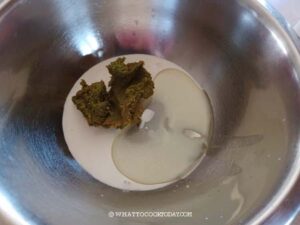
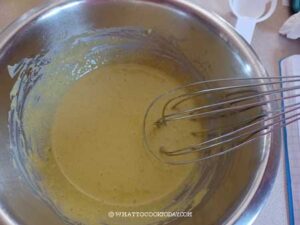
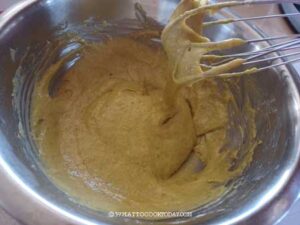
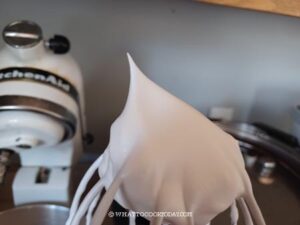
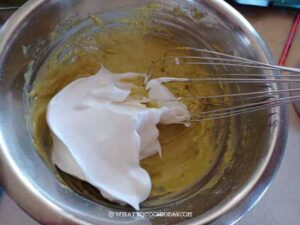
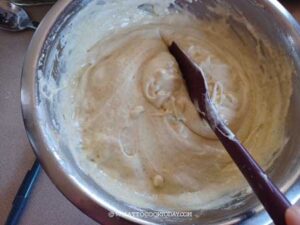
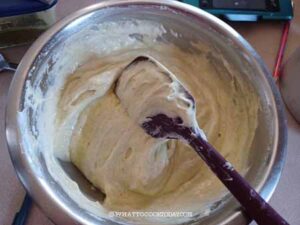
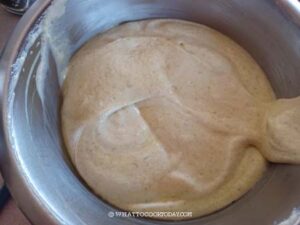
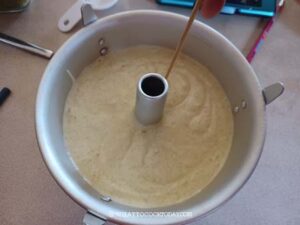
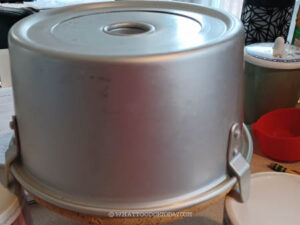
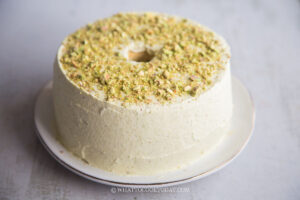
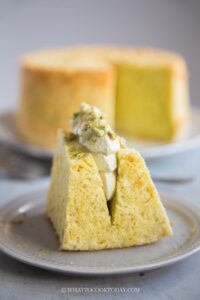



2 comments
Hi Marvellina, I’ve baked loads of your chiffons recipes with huge success before so can’t wait to try this one out!
I was just wondering if this recipe would work in an aluminium pan rather than a traditional chiffon pan? I was hoping to fill it with strawberry compote and frost for a birthday cake. Thanks so much!
Hi Aghallya, I’m glad you have had many success with chiffon cake recipes 🙂
Baking chiffon cake without a chiffon tube pan is a bit more complicated because of the risk of the cake collapsing without the middle tube supporting the weight of the cake. It has to bake using a water bath method and at lower temperature. If you want to experiment you can try these:
Preheat oven at 325 F (160 C). You need to pan, one larger than the pan you use for baking. Line the bottom of the round cake pan with a parchment paper. Pour the batter into an UNGREASED cake pan. Use a rubber spatula to smooth the surface. Gently drop the cake pan from about 10 cm height on the counter 2-3 times. This helps to pop large bubbles. Put the cake pan inside another larger pan. Fill the large pan with hot water, about 1 inch high. Gently transfer to the oven and bake on the middle rack for 1 hour 30 minutes. The cake should bounce back when you gently touch it. It should be dry to touch. The cake shouldn’t jiggle when you gently shake the pan. A cake tester should come out clean inside the cake batter.
Take the pan out from the oven. Wipe the bottom of the pan because it’s wet and drop the pan from about 10 cm height several times to minimize shrinkage. Run an offset spatula or rubber spatula around the side of the pan to loosen the cake. Invert the cake onto the cooling rack to release the cake and then flip it back. Let it cools down completely on the cooling rack before slicing
The idea is to let the cake bake and rise slowly so it won’t collapse when you pull it out from the oven.